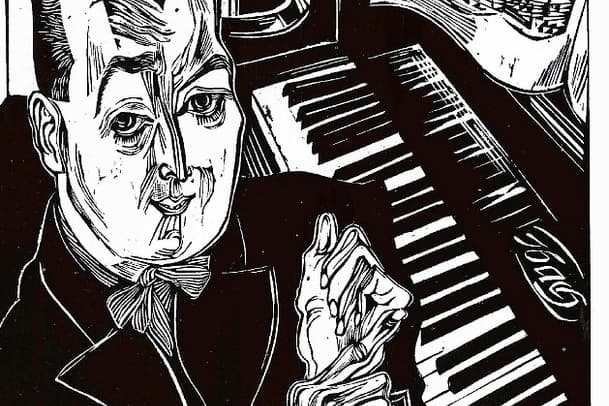Erwin Schulhoff is one of the most tragic, fascinating figures in twentieth century music. His promising career was halted by the rise of the Nazis, and he died in the Holocaust in 1942, before he could fulfill his true musical potential. His incredibly engaging music fell into obscurity after his death. Fortunately, many musicians and music lovers are re-evaluating it and bringing it back to concert stages.
Here are thirteen facts you should know about Erwin Schulhoff:

Erwin Schulhoff and dancer Milča Mayerová, ca 1931
1. Erwin Schulhoff was born in Prague on 8 June 1894 to a wealthy wool merchant father and a German mother who supported her son’s artistic ambitions. The family was musical. His great-uncle Julius Schulhoff, born in 1825, was a pianist and composer who was encouraged by Frédéric Chopin. Unsurprisingly, given that family background and their support, Erwin proved to be a very musically precocious child.
2. Erwin began attending the Prague Conservatory when he was just ten years old, per the recommendation of Antonín Dvořák, who had championed the young boy’s work before he passed away in the spring of 1904. He studied piano performance and composition there.
3. Later, accompanied by his mother, he traveled around Europe to work with several renowned teachers. He went to Paris, where he studied with Debussy, and Leipzig, where he studied with Max Reger. He won the prestigious Mendelssohn Prize twice, in 1913 for piano performance and 1918 for composition, which helped provide the resources to continue his studies in those fields.

Woodcut by Conrad Felixmüller of the composer Erwin Schulhoff, Prague 1924. Lindenau-Museum, Altenburg, VG Bild-Kunst. © Leo Baeck Institute
4. In between winning his Mendelssohn Prizes, he served in the Austro-Hungarian army during WWI, a trauma that would remain with him for the rest of his life. He was wounded twice on the Russian front, and he ended the war in an Italian prisoner-of-war camp.
5. His passion for music continued unabated through the war. In 1919 he wrote about why he was so attracted to avant-garde movements: “The idea of revolution in art has evolved for decades, under whatever sun the creators live, in that for them art is the commonality of man. This is particularly true in music, because this art form is the liveliest, and as a result reflects the revolution most strongly and deeply–the complete escape from imperialistic tonality and rhythm, the climb to an ecstatic change for the better.”
6. One of his most avant-garde musical works arguably contained no music at all: his 1919 “In futurum” for piano, which contained no played notes, only rests. The score asks the performer to play “the whole piece with free expression and feeling, always, until the end,” and features difficult time signatures and extremely specific rest lengths, the details of which go completely unheard and uncomprehended by audiences. Another famous piece was his Sonata Erotica, also from 1919, which graphically depicts a woman in the throes of pleasure. Don’t listen to this one without headphones!
7. He celebrated the arrival of the Roaring Twenties and the influence of jazz in new music of the time. In 1921 he wrote to his friend Alban Berg that he often stayed out all night dancing with women, finding dance music “incredibly earthy” and inspirational.
Erwin Schulhoff: String Quartet No. 1
8. By 1923 he returned from his European travels back to Prague to start the next chapter of his life, and by 1929, he joined the faculty of his alma mater, the Prague Conservatory.
9. During this time, he continued composing. In 1924, New York Times music critic Olin Downes wrote of his Five Pieces for String Quartet, “They had spontaneous humor, sentiment, a fluent and admirable technic.” Schulhoff’s work married classical musical tradition with exciting streaks of modern dance music and joking good humor, and audiences loved it.
Erwin Schulhoff: 5 Pieces for String Quartet
10. But he began running into existential professional problems when the Nazis came to power, both because of his Jewish ancestry and because he was increasingly sympathetic to the Communist cause. (In fact, in 1932, he went so far as to write a musical version of The Communist Manifesto. Other works in the school of “socialist realism” meant to glorify Communism followed.) After the Nazis invaded Prague in 1939, he was forced to work under a pseudonym.
Erwin Schulhoff: Communist Manifesto – 1. It is high time
11. He tried to escape to America, but he had waited too long, and visas for refugees had become increasingly difficult to secure. In 1941, finally a ray of hope came: the Soviet Union had approved his request for citizenship. But before he could flee Prague, the Nazis declared war on the USSR, and arrested him and his family as enemy combatants. His wife and son were ultimately released, but he was still held captive.
12. He was sent to the Wülzburg prison, a medieval fortress that the Nazi forces had commandeered. Other prisoners were forced to do field work, but he was spared hard labor due to a sympathetic camp commander. Nevertheless, his health was poor and he died in the camp in August 1942 from tuberculosis. He had just turned 48.
13. His rediscovery began with violinist Gidon Kremer’s 1988 recording of some of his chamber music works. Today, more and more composers and listeners are embracing his work as we continue to learn more about how Nazism suppressed or destroyed such broad swaths of European culture.
For more of the best in classical music, sign up for our E-Newsletter



